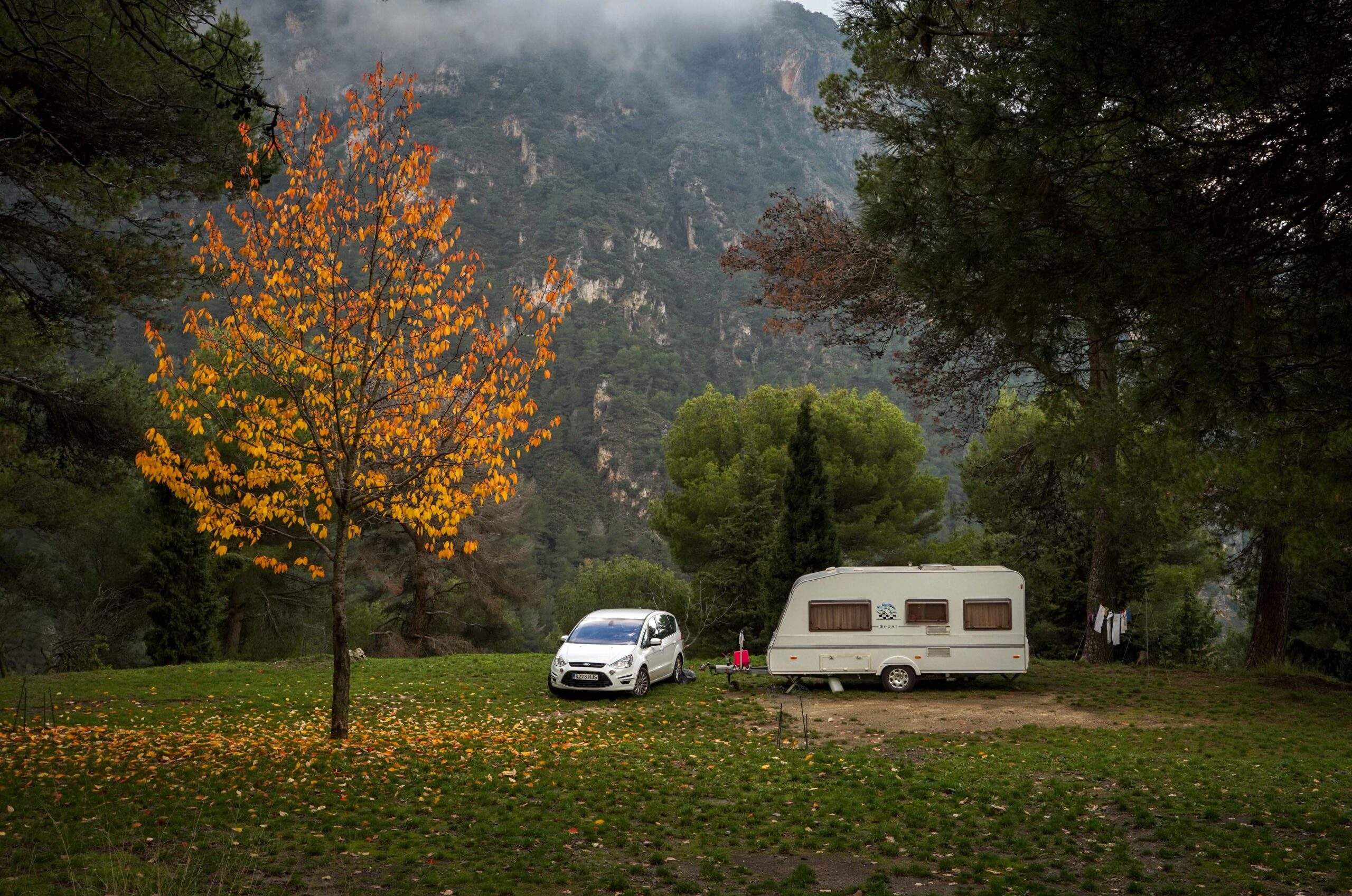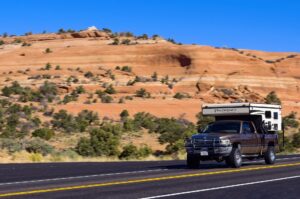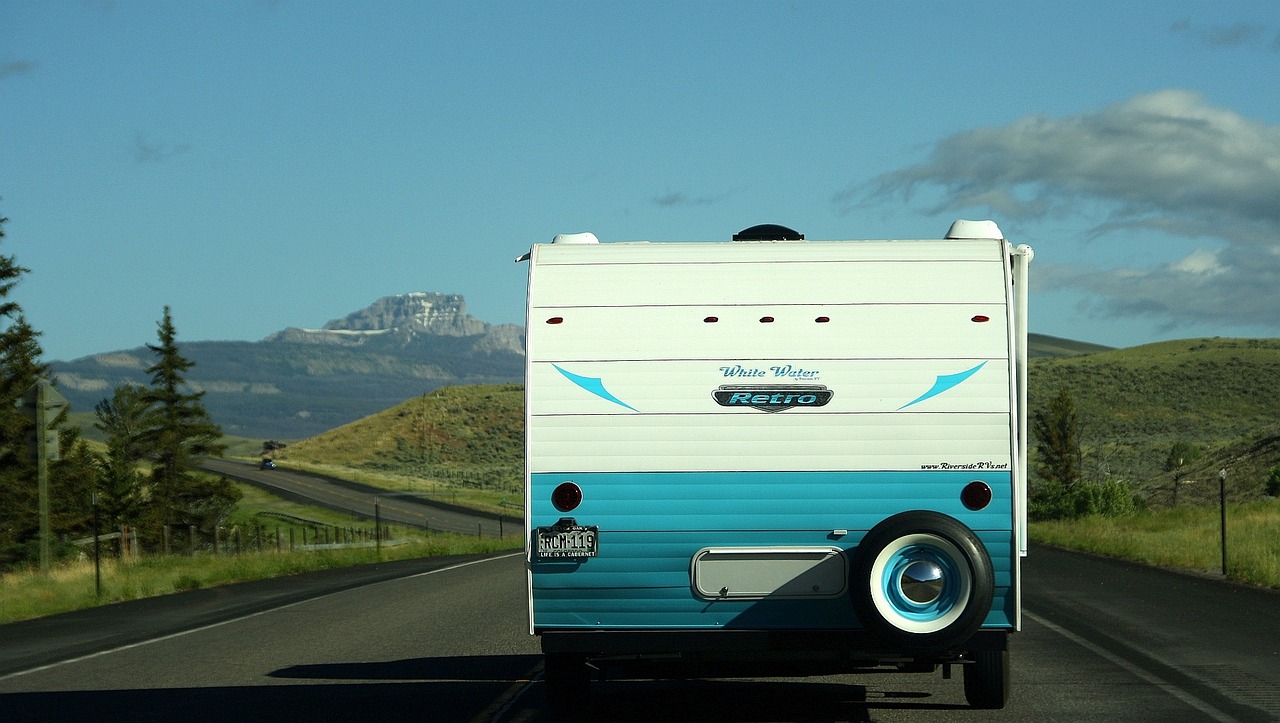In addition to the micro campers that can be pulled by a motorcycle or car, and the smaller cargo trailers which can be pulled by some SUVs, there are some campers that are lightweight enough that they can be pulled by an SUV. This is perfect if you already have an SUV, but even if you’re looking at buying a vehicle, the price of trucks is such that you may be forced to settle for an SUV. (Although this fluctuates. When my late husband went to get a truck, we couldn’t afford anything but an SUV. But when I went several years later to get an SUV, I found a small truck was more affordable than a medium-sized SUV.) So if you need a pre-built, off-the-rack camper, but you are limited to using an SUV for towing, check out these options.
This is a homemade micro-camper that might be light enough to be towed by a car (especially if you went with more-expensive, but lighter-weight materials), but should definitely be within the towing capacity of most (all?) SUVs. It actually sleeps 2 people in bunkbeds, but if you’re going it solo, the top bunk area would translate into a lot of storage. A drop-leaf table mounted on the wall near the TV would provide an indoor table to use while watching TV, and if the TV was smaller and the cabinet larger, there would be room to store a chemical potty or bucket toilet. The real selling-feature of this trailer is that it was made for just under $900. Even if you don’t have as many free recycled materials as they had available to them, with some careful shopping on Craigslist and your local Habitat ReStore, and maybe a few dumpster dives for pallets and the like, you should be able to build something similar for $1,000.
This teardrop camper has an indoor kitchen and wet bath with cassette toilet. I see a lot of people in these tour videos hating on indoor kitchens and even, in this case, the bathroom, but there’s a difference between going camping for a weekend and living in it full-time, as I am proposing in this series on alternative housing. When you’re just camping, you can choose to camp when it’s not raining or when it’s not too hot or too cold. When you’re living out of a camper, though, you don’t have that luxury. And I just don’t see wanting to cook outside when it’s blowing rain, or going outside to the use the toilet in the middle of the night when it’s 20 degrees. My husband and I did medieval re-enacting and we sometimes camped in a canvas tent in cold and/or wet weather conditions. But even in good conditions, we still had a chamber pot in our tent because we didn’t want to have to put on clothes and shoes and go out in the dark (and possibly the rain and cold) to go find a porta potty. We just hopped out of bed, pulled the pot out from under the bed, did our business, then got back into bed. (It was emptied the next morning and rinsed out.) I think if you’re looking at living out of something like this, you’ll agree you want all of these things indoors. (And nothing stops you from setting up an exterior kitchen to use on nice days. You can find portable sink/prep tables at camping stores and a folding table with a metal plate on it works just fine with a propane camp stove.)
The major drawback with this camper is the height. This is not going to be a fun living experience if you’re a tall man.
Scamps are a very popular camper for people who want something small and lightweight enough to be pulled by an SUV. This one has a small kitchen area, a dinette that makes a bed (looks like it might even be queen size, although shorter than standard) and a wet bath. One design flaw in the kitchen is that neither the sink nor the stove have covers that allow them to be used as countertops. There also appears to be room between the top of the fridge and the stove where a pull-out tray could have been added to create a work surface. As there are no countertops in this camper, that’s an issue when it comes time to prep a meal. However, you can cut a cutting board down to fit over the sink basin and make a cover to go over the stove. (These are called “noodle boards.”) This is not as nice as the fixtures that are designed to convert into completely flat counters, but it’s better than having nothing at all.
This small camper is unique in that it’s very customizable. The entire interior is made up of a series of padded storage cubes and the occasional table or countertop surface and, like a lego set, you can put them into whatever configuration you want. Even the flooring is modular and removable. It also features a large rear door, allowing you to remove some or all of the cubes and use it as a cargo trailer. A larger model (probably not towable by an SUV, though) comes with a wet bath, although it’s possible to at least put a bucket toilet into this model. So, if you like the idea of a cargo trailer because you need both a camper and a trailer, but you’re not up to building one yourself, this might fit your needs.
This video features 5 new campers, all of which should be towable by a small or mid-size SUV (and the last one, the pod, should be usable with a car). Only two of them feature a wet bath and the remainder have little, if any, place for even a homemade bucket toilet, so most of these may not be an option for you if you have to get up in the middle of the night to potty. On the positive side, however, most are cheaper than a new car, so if you want to take a sabbatical year and hit the open road, the payments should be something you can afford using your savings or doing some part-time or side-hustle work as you travel. (One car nomad I saw said she liked to work in coffee shops for a month or two when she needed to refill her coffers because she not only got free coffee, but she got to meet a lot of different people and really learn about the place where she was staying; and these jobs have high turnover, so it’s typically easy to get a job as well as leave it).
This video features 8 new, small campers that all contain a full bathroom (some are wet, some are dry). Most of these should be towable by a mid-size SUV (although I would definitely recommend campers that come with their own separate braking system and a towing package for your SUV that allows you to engage the brakes; the towing capacity of an SUV is not the same as the braking capacity, and trust me, when you’re towing a heavy load, you are going to want that extra breaking power). For the remainder of the campers, a small truck should be enough to haul them.
This homemade camper is made on the base of a derelict pop-up camper. It may be too heavy for the largest SUVs to pull, but should be towable by a small truck (when I was a teen, we pulled a large pop-up camper with just a Ford Ranger). The builder uses mostly proper camper materials to build it, but there are plenty of ways to build it with recycled materials. I didn’t manage to capture the video, but I saw one homemade camper advertised that used the top of the pop-up camper as the roof of the new camper. If it isn’t damaged and doesn’t leak, that could be a easy, cheap option for a roof, rather than worry with all the membranes and sheeting and edging.
Need something bigger? Check out this post to explore all your camper options: Highway Homes: Exploring Options for Camper Living
Is a camper not the right option for your budget or current vehicle, but you want the nomad life? There are plenty of other alternatives available: On the Road Again – Exploring Nomadic Housing Options


